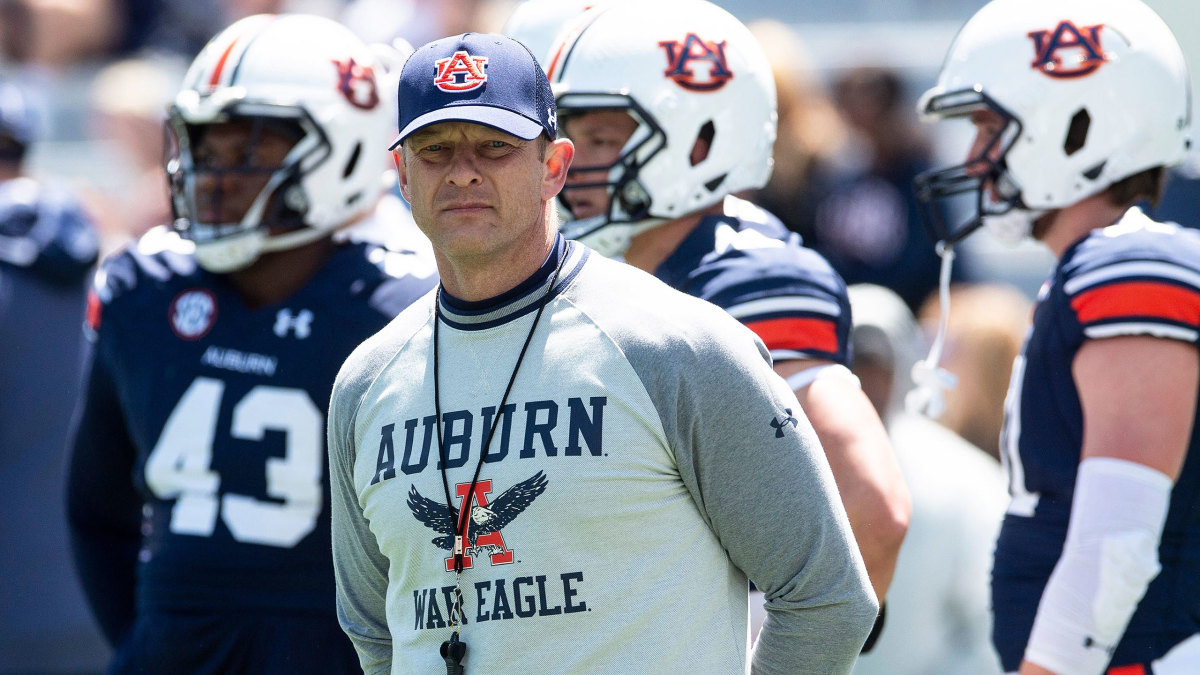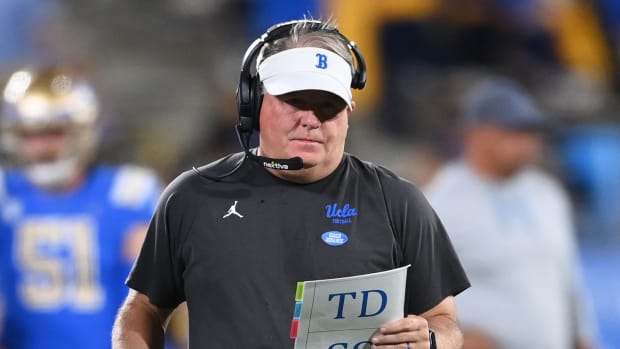The College Football Coaches Feeling the Heat Heading Into 2022
Could we be looking at a less silly “silly season” this fall? There is some optimism within the college football coaching industry that this cycle may be less tumultuous. Heading into the season, there is only one bona fide blueblood job that appears to be in jeopardy (perhaps two, depending on how you view Nebraska). This is fundamentally different from 2021, when head-coaching roles in Miami and USC seemed firmly in play, and an opening at Michigan was also within the realm of possibility.
But, as we know, just because churn isn’t expected doesn’t mean it won’t happen. All coaching hell broke loose when Florida and LSU fired their coaches—which did not seem inevitable last August—and sitting coaches at powerhouses Oklahoma and Notre Dame uprooted stakes, creating unprecedented shifts. The true unpredictability in a coaching cycle seems less about who is going to get fired and more about who is going to be there. Anything seems up for grabs since those power programs can lose coaches to lateral moves. That doesn’t even include a coach moving up to the NFL, where the work-life balance is dramatically tilted in the league’s favor. More and more the league beckons. One newly minted NFL coach described to Sports Illustrated the difference between college and pro off-field responsibilities by simply pointing to his phone, noting it hadn’t dinged once during our June conversation, usually the lowest point of the college offseason.
There will be curveballs in this cycle to be sure. Someone will retire out of nowhere or turn in a dud of a start that quickly puts them out of favor with their program. But for now, here’s what we’re hearing about numerous spots that could be in play by season’s end.

Auburn
“Everything is fair game,” according to an industry source. The only certainty for the Tigers is uncertainty, and there already have been multiple canaries in the coal mine this offseason. Defensive coordinator Derek Mason left after one year and took a paycut to join Oklahoma State’s staff. Then, Bryan Harsin survived what amounted to a booster coup back in February.
“I know some of you out there looking at me didn’t expect me to be here at this time,” Harsin said at SEC media days in July. “There was an inquiry. It was uncomfortable. It was unfounded. It presented an opportunity for people to personally attack me, my family and also our program. And it didn’t work.”
Harsin didn’t back down earlier this year when another coach in a similar plight might have just settled on a buyout to take the money and run. The people who don’t like Harsin—or at the very least would rather someone else be Auburn’s coach—won’t disappear after. There is only one thing he can do to win them over: win games. Auburn’s schedule poses an early test with Penn State visiting in Week 3, along with the typical SEC West slate and Georgia from the East. Whether they keep Harsin or not, the Tigers could miss out on a golden-generation recruiting class in the state of Alabama because the recruiting prowess of the staff is already in question combined with the tough situation they’re in regarding Harsin’s status.
Hanging over all of this is athletic director Allen Greene’s impending contract, which expires in early 2023 and has not yet been extended. There is the possibility that he and Harsin are out at season’s end, or perhaps Greene moves to a new job before the end of the year. The question remains: If Harsin still hovers within that gray territory of 6–8 wins, how much will that placate his influential naysayers?
Nebraska
Things seem pretty cut and dry for Scott Frost: Make a bowl game and he has a chance at retaining his job. If Nebraska falls short again, things might get dicey. Yes, the Cornhuskers were snakebit last season, finishing 3–9 with eight of the losses coming by one-score margins. Over time, those games are supposed to even out, but Frost is 5–20 in such matchups. The Huskers also will need to turn the corner in a handful of areas for that wins number to tilt in Frost’s favor—improve their horrific special teams, embrace a new offense under former Pitt coordinator Mark Whipple, and for newly named starter Casey Thompson to step up at quarterback.
Georgia Tech
Geoff Collins’s tenure started with tremendous promise and hype but has not yet materialized into on-field success after three consecutive three-win seasons. Collins is hoping an infusion of 16 transfers (one of the highest numbers nationally) pays off. His buyout stands at more than $10 million until Jan. 1, when it drops to $7.2 million. What is significant is a nonconference schedule that includes Ole Miss, UCF and Georgia. The Jackets’ Vegas over/under is set at 3.5 wins, which speaks to the lack of confidence in them improving, especially without running back Jahmyr Gibbs, who transferred to Alabama.
Arizona State
Besides Tennessee and Miami, Arizona State’s program seems like it is most squarely in the crosshairs of the NCAA. A handful of schools are waiting for NCAA sanctions to come down in order to try to terminate a coach for cause and skip a buyout totally (mileage may vary on this approach in a court of law) or at least force a school-friendly settlement of the buyout number.
Herm Edwards and athletic director Ray Anderson are close (Anderson used to represent Edwards), which could play in the coach’s favor when all is said and done. But the specter of the NCAA investigation is clearly harming recruiting, and it’s only a matter of time until that shows on the field. The timing of when a notice of allegation could come remains a moving target, as ASU president Michael Crow told The Athletic in early August that the NCAA’s investigation was moving “deliberately.” But ASU is a job that would, if open, be attractive to many types of candidates.
Louisville
If Louisville struggles this season under Scott Satterfield, it’ll be a real test of a classic hot-seat-coach life raft: the impending recruiting class.
In the past, a good class has been enough to save many coaches whose tenures were in peril. But how much sway does it have in a one-time transfer-portal-happy era? Louisville is punching far above its weight class, anchored by five-star RB Rueben Owens and QB Pierce Clarkson. Coaches acknowledge that high-school recruiting is still the way to sustainably build a roster, so the future looks bright for the Cardinals after a rocky start to the Satterfield era—which included him having to publicly apologize for interviewing at South Carolina during the 2020 season. Satterfield should be able to sell the future, absent a total collapse on the field.

UCLA
It’s clear AD Martin Jarmond and other key decision-makers at UCLA want Chip Kelly to work out as their coach. Kelly signed an extension in January after an 8–4 season, his best year at the helm. His buyout is school-friendly, and according to the L.A. Times, if he’s fired at the end of the season, the school would be on the hook for 70% of what’s owed through Dec. 15, 2023 (around $4 million). The extension is certainly a renewed commitment, but the structure is a substantial hint that if things don’t continue at this level, Bruin brass could move on without much monetary commitment to prepare for the future in the Big Ten.
Colorado
Karl Dorrell was an off-the-beaten-path hire when it happened but, after a surprising 4–2 record in the pandemic-reduced 2020 season, the Buffs slipped to 4–8 in ’21. Dorrell was hired by athletic director Rick George, and there are some in the industry who don’t think it would be a surprise to see CU stay the course.
North Texas
After back-to-back nine-win seasons, North Texas is 14–21 in the past three seasons. Seth Littrell, whose contract runs through the end of 2023, has undoubtedly raised the profile of the program. UNT is a G5 program willing to pay—Littrell’s salary is between $1.3 million and $1.8 million. Its location near the Dallas–Fort Worth metroplex also makes it attractive for up-and-coming coaches. Some sources say Litrell missed his window by not selling high and making a jump to the Power 5 after his initial success.
UAB
Technically, the job is already open with Bryant Vincent serving as interim coach after Bill Clark’s health-related retirement over the summer. With the Blazers headed to the American Athletic Conference in 2023 and a strong foundation built on recent success in Conference USA, they’ll certainly want to keep that going this season. Vincent should get a legitimate shot at keeping the job on a permanent basis, but he’ll likely have to keep UAB at the level it’s become accustomed to—the job will have suitors due to the AAC shift.
USF
It’s been a tough two years for Jeff Scott. He has only three wins over that span, but a source close to USF believes Scott might be O.K. if the Bulls can show progress this season. The extension he signed in early 2022 is proof of that. There’s momentum building behind the scenes, with increased fundraising pointing toward an on-campus stadium finally on the way.
Middle Tennessee
The Blue Raiders returned to a bowl game and to the standard Rick Stockstill has expected since taking over the program in 2006. We’ll see what the program’s immediate goals are after this season, considering it’s in a rapidly expanding population center if it falls short of that this season.
Texas State
Jake Spavital is 9–27 over three seasons. The Bobcats remain a transfer-heavy unit, again signing the vast majority of their recruiting class through the portal despite being in a talent-heavy state. If it pays off, experienced talent can offer a boost and quickly turn things around, but it didn’t work last year (the team finished 4–8, the most wins of the Spavital era). Its location will appeal to coaches, but questions remain about the program’s financial devotion to football and hints that its problems may not all be on Spavital.
Syracuse
Dino Babers’ last extension was three years ago, and the Orange have not had much success since that 10–3 season in 2018. Some believe it’s postseason or bust for the Orange, but athletic director John Wildhack said this in late June:
“Dino’s not on the hot seat,” Wildhack said, and then repeated, during a media availability Tuesday afternoon previewing the upcoming athletic year. “I’m really pleased with what we’ve done in the past six months, and I think it is a table setter for what we can accomplish in 2022 and beyond.”
Also of note, Babers’s buyout is hefty. ESPN reported it would cost more than $10 million to fire him this year.
More College Football Coverage:
• Georgia’s Stetson Bennett Is Ready for More
• SI’s Preseason Top 25
• The Best ACC Games to Watch Each Week
